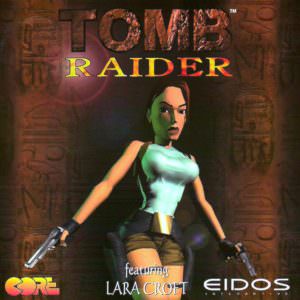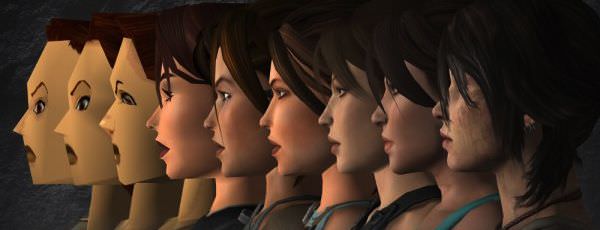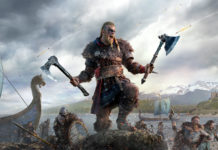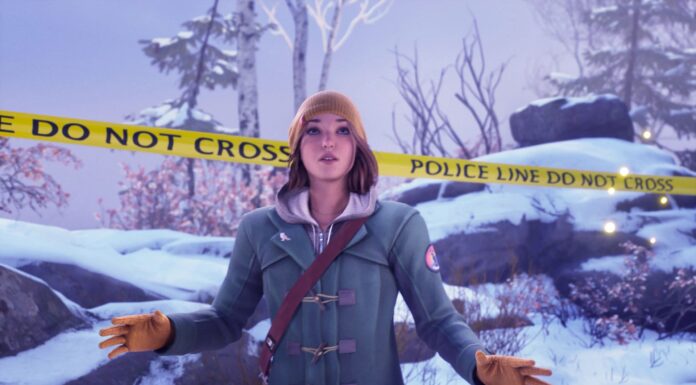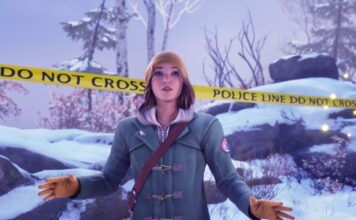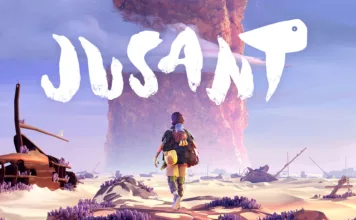Lara Croft and her games have been reimagined more than once, each point marking a decade of game design.
While Legend was the first real reboot, building a new engine, gameplay style and backstory from the ground up, I feel like Anniversary is the best one to point out how much Tomb Raider had changed. It was a honest to god remake and not simply a HD texture pack, and took subtle but definite steps to turn Lara Croft into a more fleshed out, more human character. Tomb Raider 2013’s reboot overshadows the previous one, but the reasons for that might not be in it’s favour.
I loved Tomb Raider growing up. I love swashbuckling adventure to bits, especially if there’s ancient mystery involved. For me, the original PS1 Tomb Raiders sparked a passion for archaeology. Of course, I had to get over the disappointment once I found out you don’t shoot guns or backflip off waterfalls very often, but ancient artefacts still make me giddy. As a kid though, I just loved the fantasy and Lara Croft was my patron saint of adventure.
 Something that always surprises me when I replay Tomb Raider 1 is how deafeningly quiet it is. These days people remark how the Souls series is quiet, but there isn’t so much as ambience in Tomb Raider. Just the sounds of Lara’s boots as she heavily climbs across blocky, pixelated terrain. More silent than Silent Hill, your ears strain for the sounds of an oncoming animal, or a waterfall or something, anything.
Something that always surprises me when I replay Tomb Raider 1 is how deafeningly quiet it is. These days people remark how the Souls series is quiet, but there isn’t so much as ambience in Tomb Raider. Just the sounds of Lara’s boots as she heavily climbs across blocky, pixelated terrain. More silent than Silent Hill, your ears strain for the sounds of an oncoming animal, or a waterfall or something, anything.
Lara moves slower than you want her to, it’s unforgivingly difficult, and the eerie mystery of what’s lurking just beyond the black fog wall says it all; Tomb Raider is a survival horror. This combined with a focus on surveying and navigating each map (and getting your routine down fast enough to make it to a slow-closing door in time) is what Tomb Raider is all about for me. Hell, it’s in the name; you raid tombs. You scour every corner for secrets lost by time by climbing and exploring. Sometimes you’re literally dropped into the middle of a map and left to slowly unravel the path the designers want you to take.
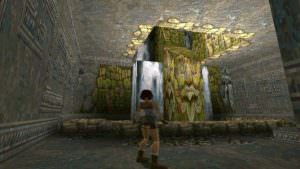 Like the treasures she hunts, Lara Croft’s game is dated too. While the unresponsive, heavy controls create a sense of panic that has you screaming “GOGOGOGO!!!” when a boulder is about to roll over your short shorts, it’s still unresponsive and heavy.
Like the treasures she hunts, Lara Croft’s game is dated too. While the unresponsive, heavy controls create a sense of panic that has you screaming “GOGOGOGO!!!” when a boulder is about to roll over your short shorts, it’s still unresponsive and heavy.
It takes a long time to acclimatise to TR1‘s controls. The stiff grid-like layout of levels combined with the unrealistic geography and anachronistic levers that activate doors, do too much to remind you it’s a game. The early 3D graphics are the video game equivalent of a medieval fresco, and while you can always tell what’s a human and what’s an animal, it’s the levels themselves that break the illusion.
But only when you think about them for too long. If you look at a button hidden 5 storeys up that unlocks the front door of a temple and ask yourself “what demented the ancient Greeks enough to build something like this”, you’re missing the point. You have to look at Tomb Raider as being impressionistic. It’s there to provide a simple sense that a place is ancient, and not to recreate an actual tomb. I know enough about ancient history to know that the textures of mosaics and bas reliefs in Vilcabamba (the very first level) are most definitely not Mayan as the game claims. There’s one room that has a huge texture of the Aztec sun calender, and the Aztecs lived in Mexico, not Peru. Anyway, Vilcabamba looks like this. Hardly the metropolis in Tomb Raider.
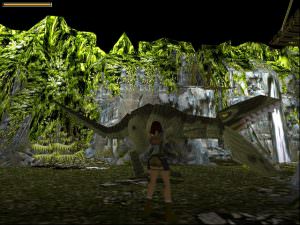 That impressionistic attitude extends to it’s writing too. With the current wave of feminism that’s calling out female game protagonists as harmful standard-setters for young girls, TR1‘s Lara is looked back on as being an objectified sex icon and little else. There’s no denying that sex appeal was part of what defined her, but I have a big issue with washing her off as being a “fighting fuck-toy”.
That impressionistic attitude extends to it’s writing too. With the current wave of feminism that’s calling out female game protagonists as harmful standard-setters for young girls, TR1‘s Lara is looked back on as being an objectified sex icon and little else. There’s no denying that sex appeal was part of what defined her, but I have a big issue with washing her off as being a “fighting fuck-toy”.
To me that trope invalidates any sexy female character’s positive traits. Lara was an icon of adventure, action, badassery, wit, proactiveness, exploration and intelligence, and she was sexy. It is of course a problem that designers or publisher or whoever demand that female characters (or real women) be sexy or cute first and then their defining traits second. When looked from a wider, cultural context, Lara is just one of many woefully sexualised female protagonists, but when looked at in the context of her own game, she’s more than that. She’s still flat and there’s no sense of biography behind her, but I view her more as an archetype the same way some people view super heroes.
Regardless, as standards for writing in games went up, Lara started to stand out as a psychopathic animal killer with more money than a small nation who steals national treasures for sport. While games like Legacy of Kain and Metal Gear Solid were coming out and focusing on more realist characters with fleshed out biographies, Lara’s fantastical take on archaeological globe trotting and her existence as a pulpy 90s comic character fell out of favour.
After the disaster that was Tomb Raider: Angel of Darkness killed off a resurrected Lara Croft, amid criticisms that the series had begun to stagnate after six games and two poo-y films, Lara was given the reboot. Legend nudged the franchise in a new direction, with an all new engine and a much, MUCH more mobile Lara. This combined with a new love affair with gunplay lead to fast albeit basic run n’ gun battles. While I don’t think Tomb Raider should ever focus on shooting, basing it around mobility and situational awareness over taking cover and regenerating your health is the lesser of two evils.
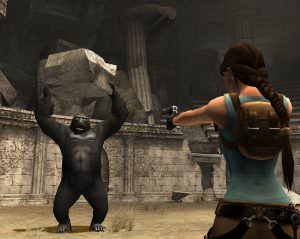 Anniversary took Legend‘s engine and remade TR1 from scratch. Now much lighter on her feet, Lara’s climbing has a new sense of speed. Thankfully gunplay takes a backseat to good ol’ platforming and exploration. All in levels that actually look like structures instead of video game maps. They’re just as unrealistic and fantastical as before, make no mistake, but they feel more cohesive. TR1 strangely feels like a climbing simulator at moments, but now with a fluid movement system and geography to accommodate it, traversing ruins in Anniversary is more free form.
Anniversary took Legend‘s engine and remade TR1 from scratch. Now much lighter on her feet, Lara’s climbing has a new sense of speed. Thankfully gunplay takes a backseat to good ol’ platforming and exploration. All in levels that actually look like structures instead of video game maps. They’re just as unrealistic and fantastical as before, make no mistake, but they feel more cohesive. TR1 strangely feels like a climbing simulator at moments, but now with a fluid movement system and geography to accommodate it, traversing ruins in Anniversary is more free form.
The eerie, survival horror vibe is hardly there any more, and that impressionistic sense of design is now animated and stylised. Anniversary, despite being much more detailed, somehow actually feels less realistic than TR1. Characters have a style of animation that reminds me of Pixar, while the original game felt like an attempt at creating real humans with blocks. This combined with a lack of a fog wall and increased clarity, as well as a less punishing save system and more intuitive controls makes the game more fun, to put it simply.
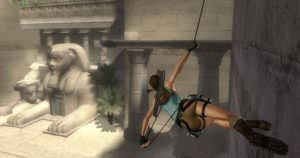 There’s less fear when making a jump and if you mess up, Lara doesn’t hit the earth with a heavy, meaty thud any more. Nor does she bleed or get impaled on spikes. According to the unlockable commentary (which is something I wish every game had) this was a standards decision to keep the age rating down. Despite how lighter Anniversary‘s style is , the ESRB felt that showing Lara get injured or mutilated would be too extreme for a T rated game. The team opted to leave the gore out to avoid an M rating. Oh the irony…
There’s less fear when making a jump and if you mess up, Lara doesn’t hit the earth with a heavy, meaty thud any more. Nor does she bleed or get impaled on spikes. According to the unlockable commentary (which is something I wish every game had) this was a standards decision to keep the age rating down. Despite how lighter Anniversary‘s style is , the ESRB felt that showing Lara get injured or mutilated would be too extreme for a T rated game. The team opted to leave the gore out to avoid an M rating. Oh the irony…
Compared to Legend, combat in Anniversary is defensive and simply serviceable. There was an effort to make each animal you encounter more vicious and aggressive to make players not feel quite as bad about killing endangered species. You evade and dodge while shooting, sometimes going for a one-shot kill counter attack if they try to charge you. For me, this is what Tomb Raider combat should be like; only kill out of self-defence and make sure you’re using your platforming skills to survive. Combat should only be a detour. The backbone of the game is platforming and exploration.
 This also took big steps to make Lara more empathetic as a character. While the broad strokes of Anniversary and TR1 are the same, Anniversary adds in little details sometimes only amounting to a facial expression that show Lara has some humanity in her. Her motivation for hunting down the game’s MacGuffin, the Scion of Atlantis, is tied to her relationship with her father and not simply some cheap thrill seeking. All of these small changes throughout the entire game add up to make her likeable and sympathetic.
This also took big steps to make Lara more empathetic as a character. While the broad strokes of Anniversary and TR1 are the same, Anniversary adds in little details sometimes only amounting to a facial expression that show Lara has some humanity in her. Her motivation for hunting down the game’s MacGuffin, the Scion of Atlantis, is tied to her relationship with her father and not simply some cheap thrill seeking. All of these small changes throughout the entire game add up to make her likeable and sympathetic.
Still, I feel like the game industry’s shift towards novelistic or filmic writing isn’t a necessarily good thing all the time. Lara in her original form was more of a symbol or a role for players to fill. The less time you spend thinking about her story, the more time you spend filling her boots yourself. Perhaps why TR1 is more terrifying stretches into how for a moment we feel like we’re falling, because we forget that we’re playing as Lara Croft.
After Legend, Anniversary and Underworld, the series was rebooted again. This time it came with more ceremony and an entirely new, grittier, “realistic” image. Furthermore, the base mechanics were totally changed again. Levels are more linear, there’s a new RPG upgrade system, movement feels floatier and there’s cover based shooting out the arse. Like most people, the irony that you don’t really raid tombs in the new Tomb Raider spoke volumes.
 The dominantly linear level design becomes restrictive fast, and serves to create scenes rather than levels. The entire game is filmic, down to the dirt on the camera lens. There’s acted out drama between characters and a traditional arch for Lara herself. She transforms from a fleshy, weak human being to a larger than life action hero.
The dominantly linear level design becomes restrictive fast, and serves to create scenes rather than levels. The entire game is filmic, down to the dirt on the camera lens. There’s acted out drama between characters and a traditional arch for Lara herself. She transforms from a fleshy, weak human being to a larger than life action hero.
To me, Tomb Raider 2013 couldn’t be further from what the original games stood for. Likewise, it feels generic as all hell. It’s like that moment when the Tony Hawk series tried to be more like Skate rather than just refining it’s own style or throwing in the towel altogether. It’s easy to compare TR2013 to Uncharted, and not because they’re both about treasure hunting.
 Gunplay is a huge focus and functions identically to Uncharted, Gear of War and just about every other third person shooter in the past gen. Which by the time TR2013 came out was tired and unimpressive. Past Tomb Raiders had a learning curve and rules of their own that you needed to master to survive. The new reboot was so uninventive that I never felt challenged once.
Gunplay is a huge focus and functions identically to Uncharted, Gear of War and just about every other third person shooter in the past gen. Which by the time TR2013 came out was tired and unimpressive. Past Tomb Raiders had a learning curve and rules of their own that you needed to master to survive. The new reboot was so uninventive that I never felt challenged once.
For people who hated the old Tomb Raiders it was a blessing; those games were stupidly punishing and only a fraction of people who owned them actually completed them. I can’t disagree, but there was a magic to the originals that simply isn’t there in the new reboot.
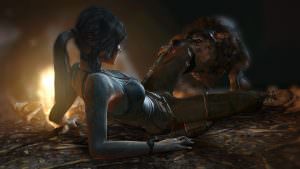 For one, it’s not as intense to play as it’s gritty horror movie image wants to seem. Lara’s movement is less consistent than before and does a lot to automatically guide players to ledges when making jumps. Previously, jumping one or two steps too early meant instant death and lost progress. The few times I purposely died to see what would happen, I was barely punished at all. Lara was, in a shockingly brutal way, but then respawned mere seconds from were she died. Between that and the abundance of QTEs, I felt like I was hardly controlling the action sometimes.
For one, it’s not as intense to play as it’s gritty horror movie image wants to seem. Lara’s movement is less consistent than before and does a lot to automatically guide players to ledges when making jumps. Previously, jumping one or two steps too early meant instant death and lost progress. The few times I purposely died to see what would happen, I was barely punished at all. Lara was, in a shockingly brutal way, but then respawned mere seconds from were she died. Between that and the abundance of QTEs, I felt like I was hardly controlling the action sometimes.
Not that I play Tomb Raider for the action. I play for the exploration and the platforming. The satisfaction of previous Tomb Raiders was clearing a room or just barely making it out of a death trap alive due to your own skill as a player. In a time were Doom and Duke Nukem had you eviscerating everything in sight, that sort of satisfaction was unique. These days it’s even more unique now that the medium’s language has become more defined/homogenized. Games across platforms play more similarly to each other than ever, and the type of satisfaction they provide is the same.
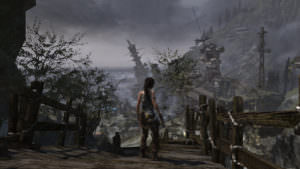 The island Lara finds herself on doesn’t feel like an island at all; it feels like a funhouse complete with waterslides and duck shoots. While there are sections were you’re free to check out sidequest “tombs” for extra experience points, they feel like token bonus levels and distractions before you’re ushered on to trigger the next scene.
The island Lara finds herself on doesn’t feel like an island at all; it feels like a funhouse complete with waterslides and duck shoots. While there are sections were you’re free to check out sidequest “tombs” for extra experience points, they feel like token bonus levels and distractions before you’re ushered on to trigger the next scene.
The camera guides your eye a little too much when climbing so that you’d have to be blind to not know which ledge to jump for next. Part of the fun of the old games, and climbing in real life, is looking at a rockface, scanning were the grips are, then planning your route accordingly. It’s a slower but more satisfying game to play and current design trends have really phased it out. Even Assassin’s Creed has come up with ways to cut down on climbing!
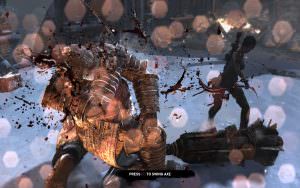 Combat seems to be Lara’s forte now, but she takes more of a beating than ever. I swear they must have been making up for lost time with the previous, bloodless reboot because new Lara takes so many slams and stabs and she must have regenerating health outside of gameplay too.
Combat seems to be Lara’s forte now, but she takes more of a beating than ever. I swear they must have been making up for lost time with the previous, bloodless reboot because new Lara takes so many slams and stabs and she must have regenerating health outside of gameplay too.
She’s more talkative and introspective but despite how much more vulnerable the story tries to make her seem, she kills more men in a single game than the rest of the series combined. I found myself judging her on her actions, not my own. I didn’t want to do most of what she did, and my own imagination never had much time to run wild. Lara has gone from a flat, archetype to someone who tries to be more human and less objectified. It makes her “psychotic” behaviour in this game even more concerning. There’s a line between self defence and genocide, and new Lara well and truly crosses it!
There’s a phenomenon with gamers that has them say “I climbed the building – I beat the boss – I died in that trap” when they talk about what they’re playing. You, like an actor, can play a character or a role. With the push to make game writing “better”, often times it results in divorcing a player from gameplay. When you play a game and it’s unresponsive, you might find yourself blaming the character for fucking up. But now we have a style of action marked by QTEs, “scripted” events and intrusive storytelling that make me do the same thing even when they work. I’m reminded that Lara is making those jumps, not me.
Tomb Raider is a series that’s coming up on it’s 20th anniversary. It has existed on four generations of consoles and through two decades of design trends and philosophy. The pursuit of “realism” in games (which in reality is a pursuit of filmic polish) has robbed Tomb Raider of what once made it unique and, in fairness, hasn’t done all that much to make Lara a more likeable person. The benefit is that she’s no longer a sex icon, but now it begs the question as to what she is an icon of any more. To me, she’s an icon of homogenised game design, or shooting dudes in the face and holding forward while cool animations happen around her.
Obviously I’m not a fan of what the series has become but it’s fine if you disagree. It’s interesting to look at Lara and her games to see how some things remain the same but others change so dramatically they’re almost opposites. Still, I miss raiding tombs.

